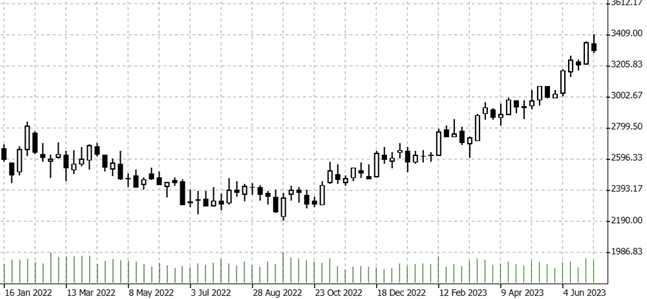

10.07.2023 – Everyone knows the villain “Goldfinger”, not only 007 fans, but “Chocfinger” is probably rather unknown to most: It is an investor who had tried to corn the cocoa market in 2010. In other words, he bought up all the goods available in Europe in order to drive up the price. This only succeeded in the short term. Last week, many felt as if “Chocfinger” had reappeared.
We get to deal with cocoa again: The price has been running – with completely natural setbacks – up like clockwork for almost a year. You can see the weekly chart of the US market in dollars per ton. Perhaps events in Europe will push the price even further north.

Namely, in London, cocoa futures jumped quite a bit last week. The news agency Bloomberg just reported breathlessly: “The biggest cocoa trade in more than a decade is rattling the London exchange.” According to the report, downright panic buying by chocolate manufacturers was underway because stocks were falling. This had led to a massive squeeze and the July cocoa contract was trading at a premium of 240 pounds per ton over the following contract.
Just like Armajaro in 2010.
The last time such a phenomenon occurred was in 2010, according to Bloomberg, when a fund called CC+ struck: according to Wikipedia and Medium.com, the hedge fund, part of the investment firm Armajaro, secured about 240,000 metric tons of cocoa on July 17, 2010. Which drove the price to its highest level since 1977. The deal was worth 658 million British pounds and accounted for about 7 percent of annual cocoa production. That was the entire European supply at the time.
Behind it was trader Anthony Ward, co-founder of Armajaro. As luck would have it, he had previously been head of the European Cocoa Association. So he obviously had inside knowledge of the demand for chocolate. Not really fair, all that. Ergo, Ward acquired the nickname “Chocfinger.” Incidentally, according to the Wall Street Journal, the deal didn’t work out at the time – a worldwide oversupply in the following months caused prices to fall.
The buying panic continues
Will history repeat itself now? Already about three weeks ago, analyst Sergey Chetvertakov of S&P Global Commodity Insights had stated at the request of the television station CNBC: “The cocoa market has experienced a remarkable surge in prices (…) This season marks the second consecutive deficit, with cocoa ending stocks expected to dwindle to unusually low levels.” He said the El Nino weather phenomenon could exacerbate the trend because little rain is expected for West Africa – Ivory Coast and Ghana account for about 60 percent of production. The price could climb to $3,600 over the course of the year, Chetvertakov further warned. So as you can see, amazing things are happening in cocoa. We are keeping an eye on the market for you!
__________________________________________________________________________________________________________________________________
The content of this publication is for general information purposes only. In this context, it is neither an individual investment recommendation or advice nor an offer to purchase or sell securities or other financial products. The content in question and all the information contained therein do not in any way replace individual investor- or investment-oriented advice. No reliable forecast or indication for the future is possible with respect to any presentation or information on the present or past performance of the relevant underlying assets. All information and data presented in this publication are based on reliable sources. However, Bernstein Bank does not guarantee that the information and data contained in this publication is up-to-date, correct and complete. Securities traded on the financial markets are subject to price fluctuations. A contract for difference (CFD) is also a financial instrument with leverage effect. Against this backdrop, CFD trading involves a high risk up to the point of total loss and may not be suitable for all investors. Therefore, make sure that you have fully understood all the correlating risks. If necessary, ask for independent advice. CFDs are complex instruments and are associated with the high risk of losing money quickly because of the leverage effect. 68% of retail investor accounts lose money trading CFD with this provider. You should consider whether you understand how CFD work and whether you can afford to take the high risk of losing your money.7
